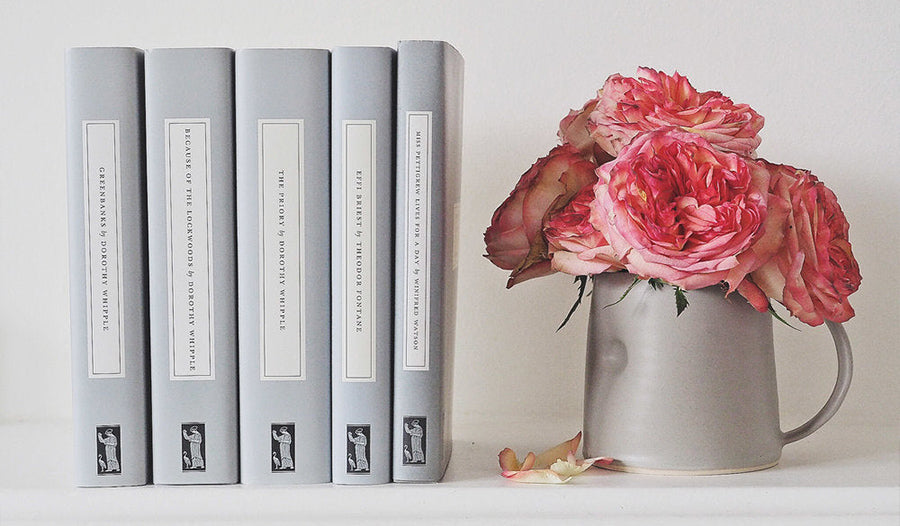
BEGINNING AT THE END

If a beautiful book is always a pleasure, a whole series of them is literary heaven and Persephone Books are guarding the gates.
Persephone republish out of print fiction and nonfiction by women writers. A typical author in their company’s own words would be ‘extremely good, once very popular, but now forgotten’, and content ranges from novels and short stories to cookery books. To paraphrase Descartes, the reading of these books ‘is like conversation with the finest women of the past.’
But their range of 50 titles is more than a literary treasure trove, it is a complete aesthetic experience. Open a deceptively plain, dove grey cover, and uncover an array of beautiful fabric designs. The fabrics are essential to the Persephone experience; they do not just decorate, they enhance meaning. The endpapers are crucial to the books.

The catalogue has an informative note about the fabric design used for each of the 50 titles, and explains how the design and history of every fabric is relevant to the book it ornaments. Persephone’s philosophy embraces the idea that ‘fabric design should be celebrated for its own sake; and because it is a field in which women designers have been particularly prominent we like to use their work wherever possible.’ The harmony of the binding with the contents of the book is not only attractive, it also gives the reader a feel for the period of the book.
In the delightful coming-of-age novel Mariana by Monica Dickens, a Calico Printers’ Association voile dress fabric design has been used. With clear bright colours reminiscent of the happy English summers of the novel, it is the kind of dress fabric that the heroine herself might have favoured.
Some have even more detail – Fidelity by Susan Glaspell is the story of one girl’s escape from her family to be with a married man and her acceptance of the consequences. Fidelity’s endpapers feature a 19th century ‘Log Cabin’ quilt, a fitting match as the fictitious family of the novel live in Iowa, near where the quilt was made. Its domestic associations of comfort and warmth make it a poignant choice.

The Victorian Chaise-Longue by Marghanita Laski is ‘a jewel of horror’. It describes a woman who, in 1953, lies back on her chaise-longue and is transported to Victorian times in a truly terrifying manner. Set in two eras, two endpapers have been selected; ‘shiny cream curtains painted with huge pink roses’, and Berlin-wool work roses such as those which decorated the chaise-longue. The roses echo the meeting old and the new, and the claustrophobic atmosphere of the novel.
Much admired by Virginia Woolf, Cheerful Weather for the Wedding by Julia Strachey is an appealing novel about a young girl, Dolly, who realises on the day of her wedding that she is making a terrible mistake. The butterfly endpaper, designed by Madeleine Lawrence for the Silver Studio in 1932, is not only beautiful but surely suggestive of the butterfly nature of the heroine.
Another fascinating choice is the design used for Manja, written in German in 1938, translated for Persephone by Kate Phillips. It is a sensitive novel told through the eyes of a child, depicting Germany on the brink of the Third Reich. The fabric, named Paul, is both beautiful and sinister with the look of prison bars, its deep red background reminiscent of Nazi flags.
The links between the designs and the books are a beautiful transposition of the literary and decorative arts. There is ‘no furniture as charming as books’ and no books as charming as those produced by Persephone.
Extract from the article, Beginning at the End: Persephone Books, written by Serena Trowbridge, which featured in Issue 02 Architecture.
--
Did you enjoy this article? Our first Textile Literary Festival will comprise three acts, one of which will explore fiction that features textiles through narratives. Visit out event page to discover some of the fantastic authors and writers taking part in the festival.
The Selvedge Textile Literary Festival takes place on Saturday 2 April 2022.
Book your ticket here:


1 comment
Hello, Just to say that Persephone Books do not restrict themselves to publishing women writers, they publish works by men too, for example A Fortnight in September.